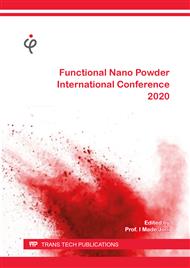p.113
p.121
p.133
p.143
p.153
p.165
p.171
p.181
p.191
Setting Time of Calcium Hydroxide from Indonesian Limestone Paste with Various Solvent Vehicle for Intracanal Medicament
Abstract:
Calcium hydroxide (Ca(OH)2 has been recently synthesized from natural Indonesian limestone to be used as an intracanal medicament for root canal infection. Ca(OH)2 is applied into the infected root canal in a non-setting paste form to release calcium and hydroxyl ions which elevates the pH and provide an antimicrobial effect to pathogenic bacteria. To form an injectable paste, Ca(OH)2 powder has to be mixed with a proper solvent to produce optimal consistency, ion dissociation, and maintain its property as a non-set material. Solvent is an important factor affecting ion dissociation and preserving its non-setting paste condition. The aim of this study is to synthesize Ca(OH)2 powder from Indonesian limestone, and evaluate the setting time of Ca(OH)2 paste from mixture of Ca(OH)2 powder synthesized from Indonesian limestone (limestone Ca(OH)2) with various solvent, to evaluate which solvent serve best to prevent the Ca(OH)2 paste from setting, to form an ideal paste be used as an intracanal medicament. This study consists of 5 groups (n=5); commercially Ca(OH)2 paste (Calcipex II) as positive control, Ca(OH)2 powder (Merck) + distilled water as negative control, limestone Ca(OH)2 powder + natrium carboxy methylcellulose (Na CMC) as group 1, limestone Ca(OH)2 powder + propylene glycol (PG) as group 2, and limestone Ca(OH)2 powder + polyethylene glycol (PEG) as group 3. Setting time evaluation was measured according to ISO 9917 by vicat needle in 37°C to mimic the physiological body condition. Results were analyzed by One Way Anova test and Post Hoc Tukey test. The result of this study showed that the setting time of Ca(OH)2 paste mixed with Na CMC solvent was 1:04 hours, PG 72:15 hours, and PEG did not harden until 7 days of observation. PEG is a hygroscopic high viscosity solvent, resulting in low and steady molecule interaction, thus prolonged its setting time. From this study it can be concluded that PEG inhibit Ca(OH)2 setting reaction up to 7 days and might be used as solvent for Ca(OH)2 paste as intracanal medicament.
Info:
Periodical:
Pages:
165-170
Citation:
Online since:
August 2021
Keywords:
Price:
Сopyright:
© 2021 Trans Tech Publications Ltd. All Rights Reserved
Share:
Citation:


